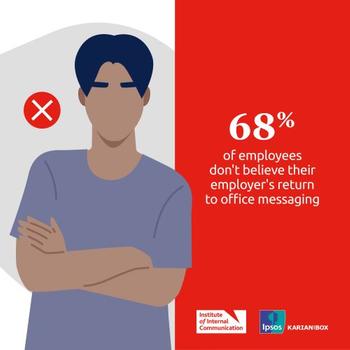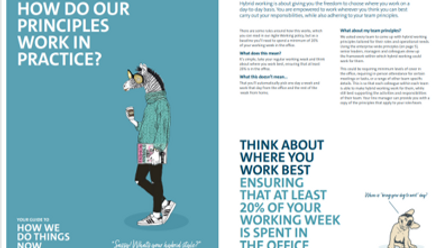In June, the IoIC published the second edition of its IC Index, produced in partnership with Ipsos Karian and Box. This important research explores the impact of internal communication on organisational performance and effectiveness.
This year, researchers surveyed 4,000 people working in the UK to expose headline insights for internal communicators. The data highlights the critical role of trust at work in boosting morale, motivation, engagement and results.
The findings of the IC Index underscore the crucial role of internal communication within organisations, not least as they attempt to navigate the continuous change that continues to define the tumultuous 2020s.
One issue that remains contentious for many is where work takes place.
While flexibility and autonomy are of increasing importance to workers across the board, ample data shows a rising determination on the part of executive teams to get things ‘back to normal’ and resume office-based ways of working.
The hybrid work conundrum

The 2020 COVID-19 outbreak saw all remote-capable organisations quickly pivot to working from home. The scramble to maintain ‘business as usual’ led to a global shortage of laptops. Many business leaders went on record to herald a new era of ‘work from home forever’.
During those long months of uncertainty, there was little choice but to trust staff to do the right thing and continue working, albeit remotely.
The promises made during the pandemic years have had wide-reaching consequences. Many people took the opportunity to relocate away from towns and cities, lured by the prospect of more affordable country living. 2021 saw a record number of people switching jobs. Many of these decisions were made based on employers’ stated commitment to remote working; jobseekers trusted their new employers to stay true to their word.
Four years on, and many remote work proclamations appear to have withered on the vine. 2023 research by KMPG found that 64% of 1,300 surveyed CEOs anticipated a full return to the office by 2026. Furthermore, 87% indicated they would prioritise those employees willing to return to the office with favourable assignments, rewards and promotions.
Hybrid work frictions
But these data clash with the expectations of modern workers. 2024 research undertaken by global staffing firm Robert Half International found that 37% of surveyed US jobseekers want a fully remote role, while 60% express a preference for hybrid working. For a third of those actively searching for a new role, locational flexibility is a priority.
In 2024 alone, various global brand names have issued full RTO (return-to-office) mandates, indicating the hybrid work debate is anything but over. The 2024 IC Index corroborates this fractious reality. It reveals a lack of trust in how the ‘return to office’ has been communicated.
More than a quarter of those surveyed say their employer mandated that colleagues spend a set number of days in the office in the past twelve months. And yet, almost 70% believe their employer lied about the rationale behind their RTO edict.
45% said their organisation cited “enabling collaboration between colleagues” as the main reason for insisting people return to the office. But only 20% of people said they thought this was the real motivation. 29% of IC Index respondents said they thought “enabling management oversight of employee working hours” was the driver for the decision.
This indicates both cynicism and distrust over the true intentions of executive teams, which is disastrous for any organisation hoping to nurture a high-trust operating environment. And as operating conditions become ever more challenging to navigate, executive teams need the trust of their wider stakeholders like never before.
Internal stakeholders must be empowered to make decisions situationally and in real-time, without having to wait for sign-off from higher up the hierarchical ladder.
Reaching consensus on hybrid is a communication issue
Fortunately, the hybrid work dilemma presents an excellent opportunity for internal communicators to add strategic value.
According to organisational psychologist and psychological safety pioneer Amy Edmondson, reaching consensus on hybrid work is all about framing. In a Harvard Business Review article co-written with colleague Mark Mortensen and published in summer 2024, Edmondson argues that language is everything.
Edmondson and Mortensen define framing as: “how an issue is presented; it’s the meaning layered onto an issue or situation that shapes how people think about its objective facts.”
Much of what has been written about workplace productivity since the pandemic has used binary language to address complex problems. The reality is that there is no ‘one-size-fits-all’ way to address hybrid. Every organisation must find its own solution.
By presenting the hybrid work dilemma as some kind battle to be fought, the media overly simplifies a complex issue and creates a ‘win-lose’ narrative. This only exacerbates tensions between internal stakeholders and their leadership teams.
In the wake of this reality, there are various steps internal communicators can take to help their leaders restore trust and arrive at a hybrid-work consensus that works for the many, rather than the few.
Help business leaders become more visible and accessible
2022 research by critical issues advisory firm Brunswick found nine out of 10 employees to be more likely to stay with an organisation when leaders are perceived to communicate transparently. Open leadership communication is key to maintaining, or restoring, trust.
Accept the complexity of the hybrid work reality
The ability to work remotely is highly context-specific. Amongst other variables, it depends on the nature of the work being undertaken, who the person is that’s doing the work and where they are in their career. And of course, the dynamics of the wider team must be considered. As already noted, many people relocated based on previous statements made about hybrid working and so consideration of this nuance and the willingness to collaborate to find solutions are key.
Choose restorative language
When seeking hybrid work consensus, use words that are equitable and conciliatory rather than divisive. It’s worthwhile considering the big picture here. Long-term organisational survival will depend on the ability of ALL internal stakeholders to respond and adapt to market forces. But they must first feel empowered to make sensible decisions in the best interests of the organisation at large. Organisational agility is contingent on trust and entrusting colleagues to make their own hybrid-work arrangements is a positive, and necessary, first step.
Embrace co-creation and iteration
As McKinsey wrote of hybrid work in 2021, “the finish line is a mirage”. By their very nature, hybrid work arrangements must remain flexible and fluid, adaptive to emergent contexts as they arise. Working in partnership with internal stakeholders to design and agree work patterns that best meet the needs of all stakeholders is key. This requires continuous and iterative conversation, bringing to life colleague voice for the betterment of all.
Conclusion
Employers face increasing pressure to resolve the hybrid work disconnect. Those that can’t offer flexibility run the risk of higher staff turnover and reduced access to high-performing talent.
Granting people the autonomy to determine their own hybrid work arrangements is a key indicator of trust. It’s also a vital first step towards organisational agility.
Market-responsiveness – the ability to nimbly adapt to changing market conditions – will determine the difference between organisational failure and success in the future of work.
But this can only be achieved when trust is mutually reciprocated by all organisational stakeholders.
Reaching consensus on hybrid and creating psychologically safe operating environments relies on inclusive, respectful, iterative discourse. Helping colleagues feel their preferences are respected is imperative and contingent on ongoing investment in internal communication.






